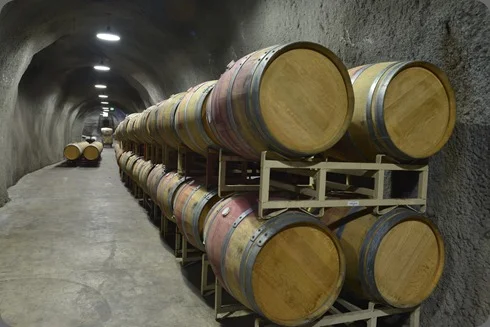You are forgiven if you forgot, or never knew, that Chiles Valley is a district in Napa Valley. Nestled in the Vaca Mountains in the northeastern part of Napa, Chiles Valley has flown under the radar. Maxville Lake Winery may change all that through their small production luxury wines.
A Napa AVA Rediscovered
Fitzgerald brings an uncommon perspective to his position. He was a server and a sommelier in some of the West Coast’s best restaurants before honing his winemaking skills. “I like interesting wines with subtle and complex characteristics that can engage your mind,” said Fitzgerald. He has the opportunity to help create such wines in a stunning setting.
“It’s a very remote area and it still has a beautiful rural landscape that’s precious,” said Fitzgerald during a recent interview with Vino-Sphere. The region is named after Joseph Ballinger Chiles, who received the territory in a Mexican land grant in 1841. He was a pioneer and wagon train guide. According to Fitzgerald, that pioneer spirit is very much alive today.
There are few other wineries in Chiles Valley, and so the AVA doesn’t have a defined signature style. What it does have is very diverse topography.
Chiles Valley has, well, a valley but also has elevations that rise 600 to 1,200 feet. Hillsides have shale soil that drains well and stresses – in a good way – the vines. The valley has clay loam soil with good water holding capacity.
Never Miss A Beat – Follow Vino-Sphere On Facebook
The diurnal temperature swing, plus cooling Pacific breezes, allow the grape skins to thicken. That allows greater tannin extractability for richer, more complex wines.
Maxville Lake Winery First Vintage
 The property was first planted to grapes in 1974 and wine was first produced there in 1999. Maxville purchased the land in 2014 and Executive Winemaker Camille Benitah and Fitzgerald began an extensive redevelopment and restoration of the vineyards. Major remodeling of the facility took place in 2016. In June Maxville Lake Winery held its grand opening.
The property was first planted to grapes in 1974 and wine was first produced there in 1999. Maxville purchased the land in 2014 and Executive Winemaker Camille Benitah and Fitzgerald began an extensive redevelopment and restoration of the vineyards. Major remodeling of the facility took place in 2016. In June Maxville Lake Winery held its grand opening. The property is exceeds 1,000 acres, most of it undeveloped. Fitzgerald says the winery is committed to sustainable farming and maintaining this important natural resource. Nearly 1,000 acres have been placed in the Napa Valley Land Trust, ensuring it will never be subdivided and will only be used for agricultural purposes.
Presently there are 100 acres under vine with 56 acres actively being used. Grapes planted are Sauvignon Blanc, Cabernet Sauvignon, Merlot, Malbec, Cabernet Franc, Petit Verdot, and Petite Sirah.
The first Maxwell vintage has been released: 2014 Petite Sirah, Cabernet Franc and Cabernet Sauvignon and the 2015 Sauvignon Blanc. The reds retail for $64.99 and the Sauvignon Blanc is $29.99.
The Sauvignon Blanc is made with the Musqué clone, which is highly aromatic. “It starts with boxwood and grapefruit then develops tropical flavors,” said Fitzgerald.
We sampled it with a chicken and cranberry entree served in puff pastry. Fitzgerald describes the aroma as burnt orange. We picked up on a yeasty flavor, no doubt accented by eight months on lees and regular stirring through the batonnage process. This is one of the most complex and enjoyable Sauvignon Blanc wines we’ve tried. The lush flavors are balanced perfectly with medium acidity.
“We’re happy how it turned out,” said Fitzgerald. “We did some brainstorming and asked what wild things could we try.” The grapes were picked over a two-week period to get different levels of ripeness. The early fruit was pressed whole cluster, while riper grapes were destemmed. Aging takes place in a combination neutral French oak and Acacia barrels (30%) as well as stainless steel tanks (60%) and concrete (10%). Talk about attention to detail!
Advanced irrigation systems allow Maxville to dial in the exact water needs for each vineyard block.“Everything we’ve grown so far is great,” said Fitzgerald. Maxville has a wine cave with a 2,000 barrel capacity. The caves are perfect for aging, with annual temperature variation of less than two degrees.
Seeing Red
Fruit is handled gently and the tanks are heated with glycol to reach fermentation temperature more quickly. A goal is to get early extraction of the phenolics, the molecular goodies that give a wine color, structure and subtle flavors. This results in finer tannins and more developed flavors.
“Our Petite Sirah has been a real eye opener,” said Fitzgerald. The Petite Sirah grapes get a five-day cold soak then undergo the quick, warm fermentation. Only free-run juice is used for the final wine. Malolactic fermentation and aging in 50% new French oak finish this dense, silky wine.
A Destination Winery
The property has a spring-fed 26-acre lake. Fitzgerald envisions boat rentals, dinners and tastings at the lake. “We want to give visitors activities and a relaxing experience,” he said.
Maxville Lake Winery is pioneering small production luxury wines in Chiles Valley. With unique microclimates, innovative winegrowing and exceptional winemaking, we expect Maxville to be a rising Napa Valley star.
Full disclosure: This wine was received as a marketing sample.






No comments:
Post a Comment